Letters from Lodi
An insightful and objective look at viticulture and winemaking from the Lodi
Appellation and the growers and vintners behind these crafts. Told from the
perspective of multi-award winning wine journalist, Randy Caparoso.
Oak Farm’s latest vineyard-designate Zinfandels are paradigms of terroir
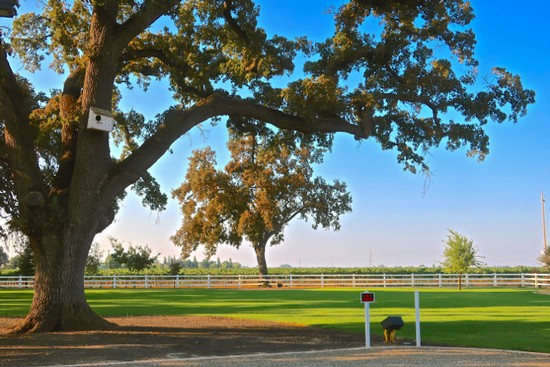
Giant, centuries-old valley oak and oversized owlbox in Oak Farm Vineyards
A quick history of terroir-focused winemaking in Lodi
What is the impact of terroir, or sense of place, on individual Zinfandel plantings in Lodi?
Terroir-related distinctions can be observed in a vineyard – felt below your feet, in the air touching on your skin, in the visible responses of individual vines to their surrounding environment – and in turn, tasted in a wine... if crafted in sufficiently focused fashion.
Most commercial wines, as it were, are not crafted to express terroir. The priority for the vast majority of wineries, especially in the U.S., is to produce wines with a year-to-year consistency of taste; to establish a particular style that results in brand loyalty; or very often, to achieve a certain varietal profile (i.e. more universal sensory qualities distinguishing grape varieties, regardless of vineyard or regional origin) that appeals to consumers and critics alike. Capturing nuances reflecting physical conditions of specific vineyards is usually way down on the totem pole; if considered at all. Mind you, nothing wrong with that. Welcome to the wine world.
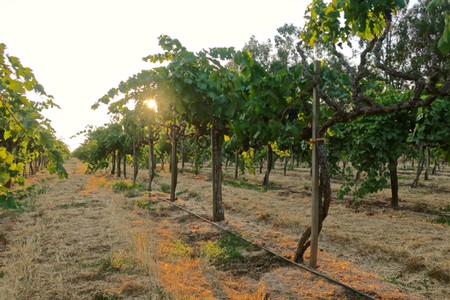
Long-spurred, trellized Zinfandel on 54-year-old vines growing in sandy loam in Hohenreider Vineyard (farmed for Oak Farm Vineyards by Lodi's Round Valley Ranches)
Yet many of the finest wines in the world – like the grand crus of Bordeaux or Burgundy in France – are, indeed, considered to be the finest because of the unique ways each individual vineyard is expressed in bottlings. The objective is still to achieve qualities that appeal to consumers and critics alike; but in a way that distinguishes each vineyard from the other. This is brand differentiation in a different, organic, much older or traditional sense. It is very European; but it doesn’t mean this doesn’t exist outside of Europe, where winegrowing traditions are newer.
Winegrowing first began in the Lodi AVA soon after El Pinal Winery in nearby Stockton was established in 1858. In fact, the oldest existing vineyards in Lodi today – Bechthold Vineyard (25 acres of Cinsaut) and Royal Tee Vineyard (a 5-acre field mix of mostly Zinfandel) – were planted in the late 1880s with material supplied by El Pinal’s nursery.
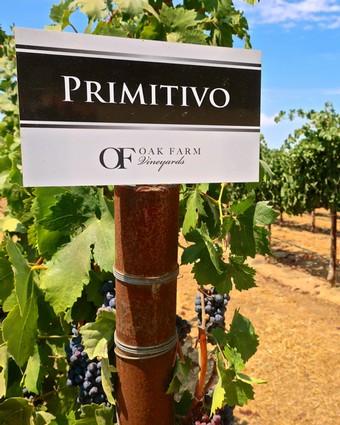
Primitivo block in Oak Farm Vineyards' estate
But up until very recently, no one – consumers and critics alike – really knew what Lodi’s individual vineyards tasted like. Many of the old-time growers and winemakers, on the other hand, always knew there were distinctive qualities coming out of their vineyards. It’s just that these distinctions were never expressed in commercial bottlings. Virtually all of Lodi’s wine grapes were going into giant vats of value-priced wines.
That is, up until recently when Lodi based producers such as The Lucas Winery (producing their first single-vineyard Zinfandel in 1978), Turley Wine Cellars (their first Spenker Ranch, a.k.a. Royal Tee Vineyard, Zinfandel in 1996), St. Amant Winery (a 1996 Mohr-Fry Ranches and 1999 Marian’s Vineyard Zinfandels), and then within the past 18 years, Macchia Wines, m2 Wines, McCay Cellars and a growing number of others began to produce wines focused on vineyard-related qualities – i.e. terroir.
Finally, people other than growers and winemakers have been able to experience, and appreciate, vineyard individuality. Now we have a better idea of what "Lodi" tastes like, as opposed to Lodi grown wines made to taste like wines that could come from anywhere.
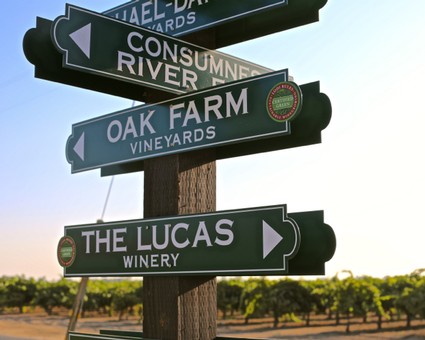
Roadsign pointing to Oak Farm Vineyards, which is 100% "Certified Green" according to LODI RULES for Sustainable Winegrowing
Oak Farm Vineyards’ foray into multiple vineyard-designate Zinfandels
For the 2017 vintage – and for the first time in their short yet multi-award winning history – Oak Farm Vineyards bottled three separate vineyard-designate Zinfandels; each showing distinctly different sensory qualities. That is: slightly different aromas, textures and flavor sensations, despite being made with identical winemaking protocols (including 80% neutral French oak aging).
To further demonstrate vineyard distinctions, this past week Oak Farm Vineyards gave us a visual demonstration by clipping field-samples of 2018 Zinfandel clusters from each of these vineyards. When laid down next to each other, you can see the differences (and similarities, of course, since they are all Zinfandels) that lead to unique, nuanced qualities that you can smell and taste in the finished wines.
The Zinfandel clusters, compared side-by-side:
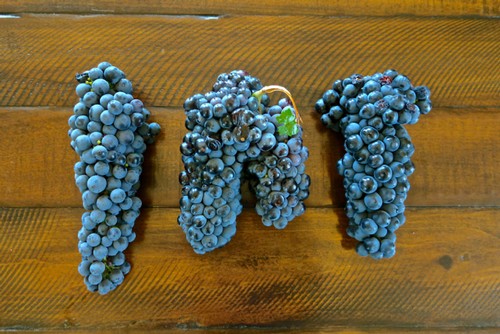
Oak Farm Vineyards Zinfandel clusters, from left to right: 1) Oak Farm Estate Primitivo; 2) Mohr-Fry Vineyards Block 417; 3) Hohenreider Vineyard
The following are the comments on the grapes and wines supplied by Oak Farm Vineyards owner Dan Panella, with assistant winemaker Sierra Zeiter and consulting winemaker Chad Joseph; along with our own notes on the 2017 Zinfandel bottlings (which, alas, will not be released to the public until about November 2018)...
Oak Farm Vineyards Estate Primitivo
“As you can see from the grape sample,” says Mr. Joseph, Primitivo gives us a consistently long, elongated cluster. The berries are fairly loose – not as tightly packed together as in most Zinfandels – which is why it is so highly favored as a Zinfandel variety less prone to mold or mildew.”
“Primitivo,” Ms. Zeiter reminds us, “is a clone of Zinfandel, although the Primitivo originated from Italy and Zinfandel more from California.” Oak Farm Vineyards planted Primitivo Clone 06 on its estate, which is one of several selections of the grape developed from material sourced directly from Italy (Clone 06, from cuttings sent from Veneto’s Insituto Sperimentale Vitcoltura in 1987). Although Primitivo and Zinfandel are 100% identical in terms of DNA profiling, the two varieties are technically considered different grape varieties. Don’t ask why.
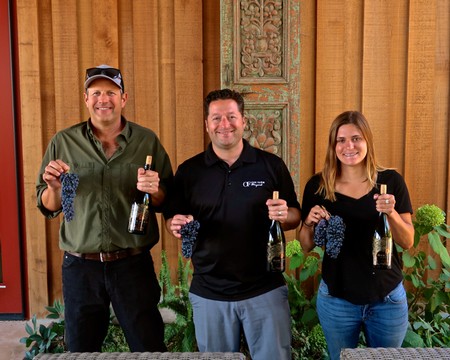
The Oak Farm Vineyards winemaking team (left to right): Chad Joseph (consulting winemaker), Dan Panella (owner/GM), and Sierra Zeiter (assistant winemaker)
But if you really must get geeky about it, you can read this on U.C. Davis’ Foundation Plant Services Web site: The first recorded presence of the Primitivo grape in Italy was in Gioia del Colle, a small town in the Puglia region, around 1800 (our note: whereas Zinfandel was not introduced to California from East Coast nurseries until the early 1850s). One theory posits that the grape migrated across the Adriatic Sea from Croatia in the 18th century. The DNA profiles for Primitivo, Zinfandel, Crljenak kaštelanski and Pribidrag (Croatia; a.k.a. Tribidrag) are identical. Despite those results, some clonal divergence between Primitivo and Zinfandel seems to have resulted due to the long physical and temporal separation of Primitivo and Zinfandel.
Says Panella, “We planted the Primitivo just west of the old DeVries home in 2012. There are 3.6 acres of it, on a trellis that allows the canopies to grow on a little bit of a sprawl to protect the grapes from sunburn.”
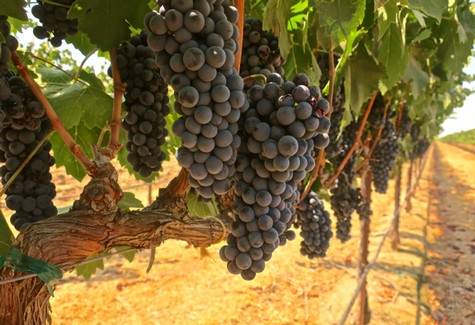
Oak Farm Vineyards' estate grown Primitivo
Adds Joseph: “We always get a real pluot-plummy fruit character from our Primitivo. It is definitely a juicier, heartier variation of Zinfandel. It has the black cherry notes consistent with many Lodi Zinfandels; with a dusty/earthiness typical of the west side.
2017 Oak Farm, Estate Lodi Primitivo ($35): Perfumed black cherry aroma wholly consistent with the clonal selection; with subtle yet distinctive loamy/earthy, almost tobacco-leafy nuances underlining the impact of the site on Lodi's west side, plus a whiff of black tea (a quality found in both west and east side Lodi Zinfandels). Medium-full bodied (15.2% alcohol), yet soft, round and very fluid, almost gushy with “Zinfulness” on the palate. Exceptionally appealing from a pure pleasure standpoint. 225 cases produced.
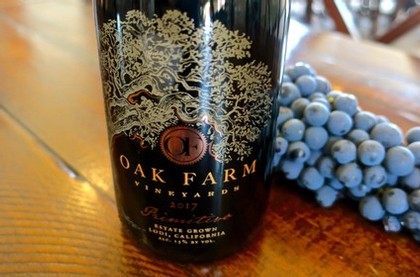
Mohr-Fry Vineyards Block 417 Zinfandel
The Fry family farms 9 separate blocks of own-rooted, head trained, spur pruned Zinfandel on their property south of the City of Lodi, just west of California Hwy. 99. “Block 417,” says Zeiter, “is Mohr-Fry's second most northern block, planted in 1945. Like the other Mohr-Fry Zinfandel blocks, it was originally planted by the Mettler family, and was purchased and has been farmed by the Frys since 1965.”
Joseph tells us: “We started working with this block in 2017. The cluster we collected is typical of what you find in their 1940s vineyards – very compact, almost rounded, often with winged shoulders, as you can see in this sample.
“Deeper rooted, old vines like this,” continues Joseph, “are also more likely to give consistent flavor profiles. I always find lighter, perfumed, almost delicate qualities in Zinfandels from Mohr-Fry’s blocks. They may seem less concentrated, or have have less dark fruit qualities than other Lodi Zinfandels; yet they are very elegant, nuanced styles of Zinfandel – often with beautiful raspberry/cherry fruit expressed in these light, smooth styles, with just hints of the earthy qualities you get in west side sandy loam vineyards.”
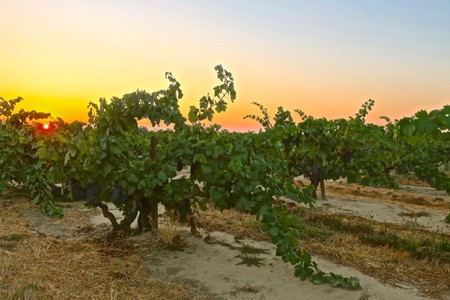
73-year-old head trained Zinfandel in Mohr-Fry Ranches' Block 417, located on the west side of Lodi's Mokelumne River AVA
2017 Oak Farm, Mohr-Fry Vineyard Lodi Zinfandel ($35): Plummy/cherry aroma with quiet, floral quality and traces of dusty, cedary as well as leafy-green notes adding up to a compelling overall package. Medium-full body (15.7% alcohol), with zesty acidity keeping the dusty, floral, plummy fruit qualities bright and buoyant, undiminished by firm yet rounded, moderate tannins. Classic style of Mokelumne River Zinfandel. 225 cases produced.
Hohenrieder Vineyard Zinfandel
Zeiter tells us: “Hohenrieder Vineyard is one of the properties farmed for us by Aaron Shinn (vineyard manager of Lodi’s Round Valley Ranches). It’s a 17-acre vineyard originally planted in 1964 on Freedom rootstock; located just north of E. Peltier Rd. next to the row crop farm east of Macchia winery.”
While this vineyard technically falls in Lodi’s Jahant AVA, according to Zeiter, the soil is a “classic (Tokay) sandy loam” – the defining soil type associated with the neighboring Mokelumne River AVA, where most of Lodi’s historic old vine Zinfandel plantings are concentrated.
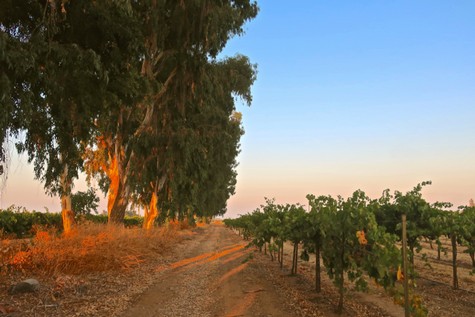
Eucalyptus trees lining the north side of Hohenreider Vineyard on Lodi's east side
Joseph points out: “Notice the compact size and berries in the Hohenrieder cluster. This gives us a very concentrated style of Zinfandel, with dark berry flavors. Unlike most Zinfandel vineyards, we get almost no wings from this planting. The vineyard is old enough that it’s self-regulating – moderate yields of fairly small bunches. It was originally planted on a California sprawl trellis, but many of the plants are more like old, head trained vines, with long, winding spurs that produce an open canopy giving the grapes just the right balance of sunlight and shading.
“But the most distinctive feature of the Zinfandel from Hohenrieder,” says Joseph, “is related to the row of big, tall eucalyptus trees on the north end. The oils, or eugenol, coming off of those these trees definitely contribute a minty character to the Hohenrieder Zinfandels. It’s earthy in a loamy sense of many Lodi Zinfandels, but also has a minty, forest floor quality – very subtle but definitely always there, and unmistakable.”
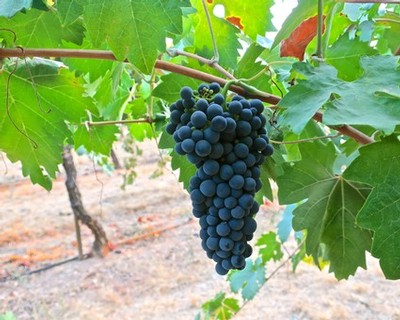
2018 Zinfandel cluster in Hohenreider Vineyard
2017 Oak Farm, Hohenrieder Vineyard Lodi Zinfandel ($35): Distinctly earthy/minty/eucalyptus notes tinging black cherry fruit qualities. These iconic, vivid qualities framed in a firm, zesty palate-feel of moderate weight (notwithstanding 15.4% alcohol); and like the other two vineyard-designate Zinfandels, a refreshing clarity of varietal as well as terroir-focused fruit, judiciously underlined by faint, at the most, oak flourishes (all three of Oak Farm’s single-vineyard bottlings aged 9 months in just 20% new French oak).
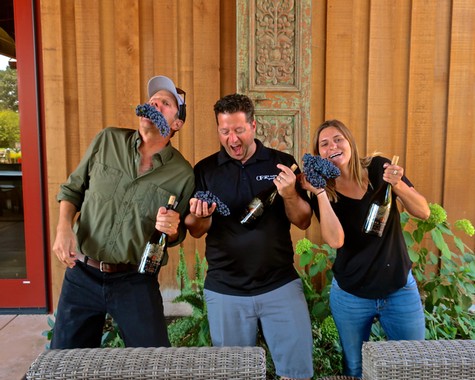
The Oak Farm Vineyards winemaking team revealing their goofier side